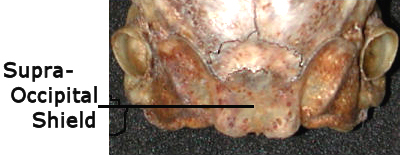1 Ear pinna as broad as long; no visible tail; premolars 2/2: Ochotonidae, Ochotona princeps.
1' Ear pinna very long; tail short but obvious; premolars 3/2: Leporidae, 2
2 Interparietal bone fused to parietals in adults; length of hindfoot usually 130 mm or more: genus Lepus, 3
2' Interparietal bone distinct; hindfoot usually 105 mm or less: genus Sylvilagus, 6
3 No anterior projection on supraorbital process, or if present, very small; skull length less than 80 mm; ear less than 75 mm: Lepus americanus.
3' Prominent anterior projection on supraorbital process; skull length more than 90 mm; ear more than 100 mm: 4
4 Whitish ventral color meeting dark dorsal color along a distinct line well up on flanks; ears without distinct black tip: L. callotis.
4' Light ventral coloration gradually blending into color of dorsum; ears with black tip: 5
5 Top of tail with black stripe that extends onto the back: L. californicus.
5' Top of tail without dark dorsal stripe: L. townsendii.
6 Hindfoot usually 92 mm or less; bullar length usually 11.5 mm or more; hindfoot/ear ratio 1.50 or less; ear/total-length ratio 0.14 or more; bullar length/basilar-length ratio 0.22 or more; sides of interpterygoid fossa slightly convex with slight shelf: Sylvilagus audubonii.
6' Hindfoot usually 92 or more; bullar length 12.3 mm or less; hind-foot/ear ratio 1.35 or more; ear/total-length ratio 0.18 or less; bullar length/basilar-length ratio 0.23 or less; sides of interpterygoid fossa straight, little or no shelf: 7
7 Supraoccipital shield convex or pointed posteriorly; anterior segment of parietal-squamosal suture straight; basilar length usually 57 mm or less; mean earlength 65 mm or less; mean hind-foot/ear ratio, 1.48 or more; bullar/basilar-length ratio usually 0.21 or more: Sylvilagus nuttallii.
bullar/basilar-length ratio usually 0.21 or more: Sylvilagus nuttallii.
7' Supraoccipital shield truncate or emarginate; anterior segment of parietal-squamosal suture convoluted; basilar length usually 52 mm or more; mean earlength 65 mm or more; mean hindfoot/ear ratio, 1.47 or less: Sylvilagus floridanus.
Key slightly modified from Findley et al. (1975).
Last Update: 4 Jan 2008